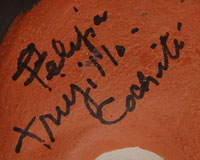Cochiti Pueblo Female Storyteller Figurine with 6 Children [SOLD]
+ Add to my watchlist Forward to Friend
- Category: Figurines
- Origin: Cochiti Pueblo, KO-TYIT
- Medium: clay, pigments
- Size: 9-1/4” tall x 6-1/4” wide x 7-1/2” deep
- Item # C3205A SOLD

It is well known that Helen Cordero made what has now been named the Storyteller figurine in 1964. Her definition of a storyteller was that it was in honor of her grandfather, a well-known storyteller at Cochiti Pueblo, so it was always a male figurine in her eyes.
Before Cordero's first storyteller, female figurines were made by potters at Cochiti and they have been named Singing Mothers or Singing Ladies. In the book The Pueblo Storyteller by Barbara Babcock, there is a Singing Mother figurine which Babcock says pre-dates 1930. She further states that "The shape of her head and ears and her 'coffee bean' eyes are remarkably similar to figures made by Felipa Trujillo in the 1960s and 1970s." If this is indeed one made by Felipa Trujillo before 1930, she must be one of the earliest Cochiti potters to do so.
Babcock also states that Trujillo began making storyteller figurines in the mid-1960s. We know that Cordero made the first one in 1964, so Trujillo must not have been far behind her. Trujillo was one of the seven artists represented in the Museum of International Folk Art exhibit "What is Folk Art?" in 1973. It seems fairly obvious that Trujillo was one of the earliest potters to make storytellers.
This storyteller figurine represents a female adult with six children. It was probably made in the late 1980s and is still in original condition. The artist name is written on the underside.
Provenance: from an Albuquerque collector of pueblo arts
Recommended Reading: The Pueblo Storyteller by Barbara Babcock

- Category: Figurines
- Origin: Cochiti Pueblo, KO-TYIT
- Medium: clay, pigments
- Size: 9-1/4” tall x 6-1/4” wide x 7-1/2” deep
- Item # C3205A SOLD



